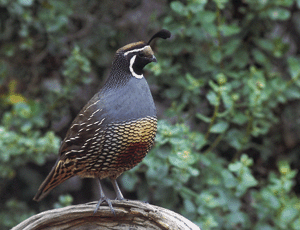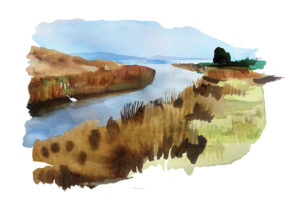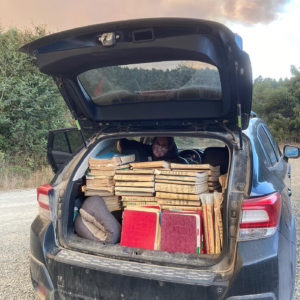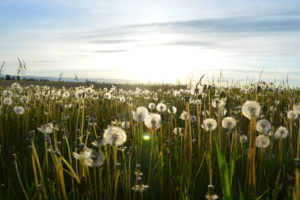Some of us living here on the north-central California coast can dimly remember metal signs affixed to barbed wire fences indicating that parts of Bolinas were once a quail refuge. The signs are gone now, but the California quail remains a feature in our lives. We don’t know in what quantities our state bird formerly clucked and fussed, courted, nested, and raised chicks when there were fewer of us, but on a foggy summer day, I can still raise a substantial winged thunder by walking out my back door. The males’ assembly call still awakens us in fall and winter. And the quail is still a familiar and beloved bird, seen rocketing at 25 miles per hour from garden to garden, rushing down the road on foot, or burbling half-hidden under coyote bush on a rainy day.
California quail are among those creatures, like deer, bear, and coyote, whose wariness varies in accordance with their accustomed proximity to humans and their status as prey. Known and respected by hunters for their uncanny ability to disappear and their dislike of letting anyone within 100 yards, they are popular here partly because of their visibility, their distinctive appearance, and the closeness they tolerate. You don’t need binoculars to identify their handsome chestnut, gray, black, and white markings; and their chicken-like plump bodies and unique forward-curling topknot, somewhat resembling a golf club, are impossible to mistake.
In exchange for room in our gardens, they give the graceful gift of thriving among us. As they skim fences, ignoring property rights and heading for what they need regardless of who owns it, they stitch the neighborhood together, providing a local totem and a topic of much conversation.
The desire to know them better is one of the guides for my backyard gardening activities. Their recent inclusion on the National Audubon Society’s list of threatened bird species gives impetus to my efforts to provide for their needs. When land management decisions need to be made, I check with the quail.
Although there are still plenty of quail throughout the state, they are losing ground in many locales. Apparently not here. I experience a sense of abundance as I watch 35 quail in my yard taking advantage of yesterday’s weeding activities to find seeds. Performing the quail dance, a “scratch scratch, peck peck, scratch scratch, peck peck” routine, this troupe of feathered butterballs in constant movement reminds me of nothing but what it is, a moving mass of quailness. It is a remnant, though, of what used to be.
J. Smeaton Chase, during his rambles up the coast of California in 1911, “wandered for an afternoon in Golden Gate Park, where I saw bands of quail running fearlessly among the shrubbery—a charming sight from which I argue that, notwithstanding the general belief, San Franciscans cannot after all be wholly bad” (California Coast Trails: A Horseback Adventure from Mexico to Oregon, by J. Smeaton Chase, Tioga Publishing, 1987).
Yet in the year 2000, Golden Gate Park, which used to boast flocks of 8,000, counted only 8 to 12 birds. The city of San Francisco, in recognition of the quail’s appeal and drastically dwindling numbers, declared it the official city bird. Habitat restoration and feral cat control efforts are now under way in several parts of the city to bring local populations back from the brink.
One of the problems quail face is that they are everybody’s dinner. Besides being prey for hawks, owls, jays, ground squirrels, ravens, skunks, foxes, and bobcats, quail have been hunted by humans for as long as we have been around. Quail were hunted early in the education of a young Coast Miwok, who “shot quail in the brush — this when it was raining, and the birds were wet” (Isabel Kelly’s Ethnographic Notes on the Coast Miwok Indians of Marin and Southern Sonoma Counties, compiled and edited by Mary E.T. Collier and Sylvia B. Thalman, Mapom Occasional Papers, 1996). Several trapping techniques, including mile-long running fences with openings, were also employed by native hunters throughout California. Quail topknot design elements, ubiquitous in California Indian baskets, speak to the importance of quail in Native Californian diets. The actual topknots were frequently incorporated into the baskets’ rims as well.

- California quail juveniles in a Mill Valley backyard. Photo by Ian C. Tait.
With the arrival of Europeans and firearms, quail hunting became a major form of commerce and recreation. Even today, quail hunters take close to 2 million birds a year throughout California. With the spread of industrial agriculture and the advent of suburbia, quail encountered still more ways to die: hit by cars, crushed by plows, eaten by dogs and cats. No wonder their average life span is only one year and seven months…
When commercial hunting and habitat destruction brought quail numbers dangerously low around the turn of the century, measures to foster quail were initiated by local and state agencies. It is likely that those signs we remember in Bolinas were a relic of a short-lived program of quail protection established in the 1920s between landowners and the Fish and Game Commission.
Other steps included artificial restocking, strict regulation of sports hunting, the elimination of horrendous numbers of quail predators, and the banning of market hunting in 1880. Here on the Point Reyes peninsula, before it became a National Seashore, hawks were routinely destroyed to leave large numbers of brush rabbits and quail for human hunters. None of these measures, however, could make up for the loss of the proper combination of dense cover for shelter, open ground for feeding, and low trees and tall shrubs for roosting.
Thinking about proper quail habitat, I wonder what this land was like before the Spanish brought thousands of cattle to graze year-round on these coastal prairies, before land was plowed up to grow artichokes and lettuce, and before gardeners appeared with their ideas of what the land should grow. One of the first acts by new residents when ranch lands were divided into lots in the 1920s involved the planting of “windbreaks” using tree species from as far away as Australia (blue gum eucalyptus) and as nearby as Monterey (Monterey cypress and Monterey pine), trees that changed a windswept marine terrace from a complex mosaic of prairie, scrub, wetland, and evergreen woodland to an increasingly simplified pseudo-forest. Other invasive species, like French broom, pampas grass, capeweed, cape ivy, and echium made the land increasingly difficult to recognize, from the point of view of quail, wrentits, Xerces blue butterflies, saw-whet owls, or a gardener looking to understand what makes her home unique.
And so now, I consider the quail’s needs as a template for my garden. What do quail really want? Food: I provide open areas where the seeds and greens of native herbaceous species can be found. Nesting: I plant native bunch grasses and leave brush piles in which to make nests. Cover: I plan shrub islands for shade, shelter, and protection from the numerous predators. Bed: And low evergreen trees for roosting. Liquid refreshment: I fashion a small pond, though quail on the coast can obtain a significant part of their liquid needs through fog and dew.
In his 1977 classic The California Quail, A. Starker Leopold says, “The basic component of the quail diet is the assortment of seeds produced by various species of broad-leafed annual plants, botanically termed forbs.” One of my gardening endeavors, which falls under the rubric “the preservation of small things,” is to grow as many of the locally native forbs as possible — the species that, while not federally listed as threatened or rare, are prone, like quail, to local extinctions. Weedy grasses, French and Scotch broom, and other exotics have replaced native violets, lupines, clovers, and many other annual and perennial wildflowers. It seems an enticing task for the native plant gardener to encourage these frequently beautiful and always interesting small ones, a natural fit between the horticulturist and the restorationist.
Quail considerations also provide a protocol for my gardening activities. If I want to clear an area of Himalayan blackberry, the invasive vine that smothers out the herbaceous species that are an essential part of the northern coastal scrub plant association, I first plant an equivalent area of dense cover, such as closely spaced coyote bush, so that the quail always have an alternative. Scrubby patches of lizard tail, western swordfern, and California sagebrush also offer good cover. Brush piles are left in place till nesting season is over.
In summer and fall, my garden produces the seed of six lupine species, the best quail food, as well as of red maids, popcorn flower, and coast lotus, all things that have been found in quail crops. The quail’s fondness for the seed and foliage of clover encourages me to reintroduce this elusive component of the ecology of the coastal prairie. In the summer and fall, when we do most of our seed collecting, so do the quail.
When the rains come and the forbs appear in winter and spring, the quail feast on sweet and succulent greens, especially the clovers and lotuses. Delicious miner’s lettuce, tangy red maid leaves, and also some weedy non-natives, like bur clover and filaree, make up the salad days for quail.
Opportunists, the quail do not pass up the seeds and leaves of some non-native plants either. I see them flying over the fence coming from the direction of my neighbors, Joanne and Donald, who have maintained a feeding station for 25 years. Here the coveys can count on year-round food, a mix of millet, from Eurasia, and other small seeds of commercially grown non-native plants. The quail like it just fine. Donald says, “Sixty to seventy quail are hanging around in our garden most of the time.” In my garden, however, I choose to set a table of the species with which the quail co-evolved. My garden is the restaurant where you can get the old-style food, the lupine seeds and native clovers of the good old days. No junk food served here.
Many gardening activities are of interest and benefit to the quail, who notice when we weed or clear areas for new plantings. The day after such an event will find the flock indulging in luxurious dust baths where we exposed the soil, sinking one at a time into a quail-shaped tub. Their orderly approach to such pleasures gives the garden the air of a European spa. Like organic gardeners, they also favor mulch, for the reservoir of ungerminated seed frequently contained within it.
Another gardener tells that when she cleared the poison oak out of her yard, so many quail moved in to the recently opened land that she could scarcely walk for their numbers. Experiencing the precious plenitude described by La Pérouse and others, she saw it as an impediment to her gardening activities. As she advanced, they retreated. So it goes for the quail, who gained new access to food from her initial clearing, then lost it by her further gardening. In general, they may be able to sustain this rise and fall if our land use practices take them into account.
However, eucalyptus trees dominate the skyline here, and I need not bother looking for quail in those stands. The question of the removal or preservation of our local eucalyptus has become a bloody battle bringing a poisonous disharmony to the town. The trees’ defenders cite their ghostly beauty, the monarchs that use them, and the hawks and great horned owls that nest in them, launching deadly forays into the world. Those who would like to see them gone point to the beauty and importance of the plants they displace, to the many butterfly species whose habitat is destroyed by their spread, to the songbirds, saw-whet owls, and spotted owls that have not co-evolved, here in West Marin, with the raptor predation made possible by the presence of the tall trees.
When I put a request for quail information in our local paper, one of the members of the pro-eucalyptus group calls me with a quail story. A chilly, eucalyptus-induced silence has prevailed between us for some time; I am surprised to hear from her. She tells of being thrilled by the sight of a covey of 50 flushed by the UPS truck. We overcome the antagonism that has been generated by the eucalyptus controversy to share in this mutual quail admiration moment. Briefly, we are in harmony. Maybe the fact that quail don’t favor eucalyptus stands will move her where the fate of the ruby-crowned kinglets, their beaks gummed shut by eucalyptus nectar, or the Xerces blue butterfly, habitat destroyed by eucalyptus, has not.
What is it about quail that evokes this affection in us? Perhaps it is because, like us, they seem to love each other’s company; and then, at other times, they don’t. Leopold says, “When quail are flushed and scattered, their main preoccupation following the disturbance is to reassemble with their companions.” However, as soon as spring’s warmth and longer days activate sex hormones, aggressiveness and irritability take over, and the covey disintegrates as pairs go off on their own. With the chicks partially raised in mid to late summer, the pairs link up with other pairs again, forming coveys ranging from 25 to 500 birds.
In their domestic lives, quail exhibit clear gender roles. Males take turns watching over feeding coveys from low trees and shrubs, roofs, and fence posts. By sharing sentry duty, they have more opportunity to eat. When paired off in the spring, the males watch over their mates as they build nests, feed, and drink. Females lay clutches of 10 to 17 eggs, and if the first one of the season doesn’t hatch, and sometimes even if it does, she’s off to try for a second batch, not necessarily with the same guy. Socially inclined, as we are, they are also in a hurry, careening speedily from cover to open feeding areas and back again. The blur of their running legs is comedic, making it almost a disappointment when they finally take to the air, which they do with seeming reluctance and only when pressed.
Resident here, the quail are born and die in our view. In the garden, they mold us back to an older contour, to the original scheme of open prairie rich with herbs, to dense coastal scrub and protective evergreen woodlands. Within the quail-appropriate spaces, many other species may flourish.
Some have it the famous quail assembly call says, “Cu-ca-cow,” or “Chi-ca-go,” but I prefer the early Spanish Californians’ rendering: “Cui-da-do.” Translated “take care,” it is a more appropriate message from these apprehensive birds. The Sibley Guide to Birds syllabifies it as “Put way do,” and the Coast Miwok who were here before us said, “Tso-ko-tok” or “hek-hek-ki.” Now when the local preschool class comes to visit, the children announce their arrival by imitating this call with gusto at the garden gate. Their voices don’t sound all that different from the real thing.
At the end of a conversation with my quail-feeding neighbors, we toast: To the quail. Cu-ca-cow, Chi-ca-go, Put-way-do, Tso-to-tok, Hek-hek-ki. Cui-da-do.

.jpg)




